Photovoltaic (PV) Solar Panel Installation - in Glasgow, Scotland
The background
This page refers to a domestic situation, retrofitting solar PV panels to an old house, where we own our roof (it is not shared, like a tenement would be).
Different scenarios will obtain for industrial and commercial premises, for newbuild houses, and for houses with several owners and a shared roof (where it may be difficult or impossible to make an arrangement for solar panels), and for all of these situations the comments below will not apply in detail.
A further caveat is that the figures quoted apply only where the panels were installed in 2011 or early 2012. The situation for installations now is different.
With the Government keen to meet renewable energy targets, and with a south of east facing roof giving a projected return of 7% of the money invested, it seemed like a good idea to take advantage of the feed-in tariff - all explained on the Energy Saving Trust's website, so we decided to install solar PV panels in January 2011, to produce our own electricity.
If you use the power you generate, you save by not paying for using that power from the grid. In addition you get the feed-in tariff from your electricity company.
If you don't use the power you generate, not only do you get the feed-in tariff, but also an extra export tariff from your electricity company for each unit of electricity which you export to them, either metered if you can persuade them to install an export meter, or more likely, deemed as 50% of what you generate.
On 1st April 2011, the feed-in tariff, previously 41.1p /unit (which is index-linked and free of UK income tax) rose by 4.8% to 43.3p per unit (kWh) generated, and an extra 3.1p per unit (but most likely only on half of what you generate) for exporting power to the grid.
On 1st April 2012 the feed-in tariff rose to 43.1 p/unit.
On 1st April 2013 the feed-in tariff rose to 45.4 p/unit.
On 1st April 2014 the feed-in tariff rose by RPI of 2.7% to 48.07 p/unit, and the export tariff is now 3.39 p/unit.
For people installing Solar PV up to 4kW peak systems as a retro-fit on domestic properties, these figures were guaranteed for 25 years. The starting rate for the feed-in tariff was expected to decline for installations after April 2012, as the panels become more efficient and cheaper, and more people take up solar PV generation.
The reduction in the starting rate of feed-in tariff
However, the UK Government has now reduced the starting rate for the feed-in tariff to less than half of what it was, while the cost of panels has gone down by less, so people who install now might see reduced returns, depending on the cost of their installation. By reading the detail below, for people still considering installing, you can see what the generation has been in cloudy Glasgow with a less than optimal east and west facing orientation, and this may help you to decide if it's worth it for you. My tentative conclusion is that it may still be worth while if you have a south-facing roof.
To find out what the starting rate of feed-in tariff is now, look at Ofgem's website
Installing the Solar PV Panels |
|||
| Installing the Sunnyboy inverter in the roofspace | Lifting Topsola PV solar panel on to the roof | Fixing Topsola PV solar panels on to the roof | Installing the solar PV meter |
|---|---|---|---|
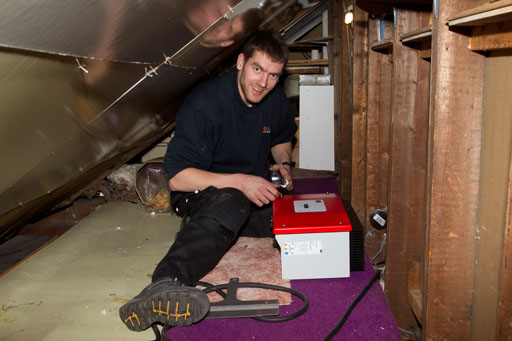 |
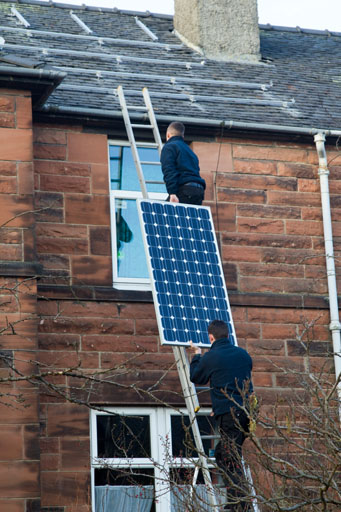 |
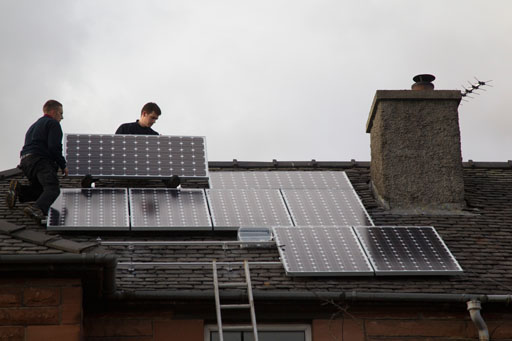 |
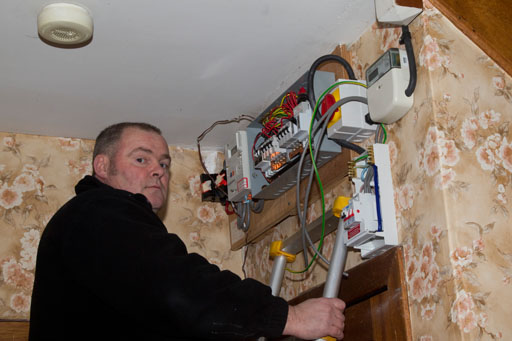 |
Some gratuitous advice if you're thinking of installing solar panels:
It may seem obvious, but get more than one quote. The reason is not just financial, but because you learn something useful from each installer who visits your house and talks about the installation.
For example, consider whether you want them to:
a) drill holes in your slates or tiles for bolts to fix the rails on which the panels are mounted, and fill them with a flexible bung, or
b) whether they use slate hooks, which means stripping some slates off the roof, and putting up hooks screwed into the roof, then replacing the slates.
The slate hooks point down the roof and come out between the slates.
Apparently both systems are approved for MCS certification.
You need to weigh up the risk of having holes in your slates versus the risk of the slate hooks cracking the slates.
It depends on the quality of the workmanship, so make sure you can trust the installation company.
If they use slate hooks, the slates might be pushed too high off the roof, so that the wind would get underneath them, so the installers should put slate-sized lead flashing in to replace the slates below and above each slate hook. That should obviate possible cracking of slates.
There is a standard called G59, which limits the output of the panels to the grid to 16 amps, so you might not be able to install the full 4kW output, depending on the efficiency of the inverter. Your installer might be limited by the electricity provider to a maximum of 3.7kWp or even 3.6kWp.
Generation and Payback Summary:
How well do Solar PV panels work in cloudy Glasgow? The plan is to update this page as often as significant developments occur, to keep a record of how worth while the investment has been.
See the table below for a summary of the latest output in December 2019.
The figures in the table take no account of electricity savings (and since excess solar PV is now diverted by a Solar Immersion Switch to heat the hot water, also in gas savings), so at a guess the payback period is probably more like 12 years, (depending on how much the price of energy goes up).
Hot water heating by gas only starts in early November, when it needs only 10 minutes per day, rising to 20 minutes if it's been cloudy for two or three days in a row) to keep the hot water temperature up to 50 degrees. In December and January, depending on how cloudy it is, virtually no heat is produced from the Solar Thermal, and very little generation from the Solar PV (up to 1 unit per day if the sun shines) from 20 panels, so we are reliant on gas for the darkest two months of the winter.
Generation Summary Table:
Some data is missing due to having to reset the Sunny Beam monitor on more than one occasion, probably due to software errors in it.
The table below reads like a blog, with the most recent information added at the top.
If you want to read the history, start at the bottom and work up.
If you want a summary, start at the top!
| End of Month | West-facing cumulative total | East-facing cumulative total | Cumulative Total (East plus West Arrays) | Monthly total | Units per day | Notes |
| 13 December 2019 | 19000 | SUMMARY - Today the total reached 19,000 units of electricity generated in total, which means that from 20 panels totalling 3.7 Kw peak in cloudy Glasgow, in a non- optimal orientation, the average generation was 3177 units per year or 8.7 units per day. At the current feed-in tariff rate of about 50p per unit (only available if you installed in about 2011), the yearly income from the panels is about £1500 per annum, which is more than the total energy bill (electricity + gas) for the year, but the panels did cost about £14,000 to install in 2011. The panels and inverters are still performing well after 8 and a half years of operation. | ||||
| 3 March 2014 | 6145 | Following a very cloudy winter, when Scotland had 50% more rainfall than average, the sun finally came out on the 1st of March. Instead of using 10 or 20 minutes of gas-fired water heating every day during the dull cloudy days of November to February, we have now used no gas at all for heating water for the past 3 days. The temperature at the bottom of the tank has risen to 57 degrees and the top of the tank has risen to 67 degrees, at 4.20pm, and the sun is still out and water is still being heated. This high temperature should last a couple of days of usage, even if the sun isn't so obliging for a few days, so I predict little use of gas from now until the end of October. | ||||
| 13 November 2013 | 6000 | |||||
| October 2013 | No gas used until the end of October for hot water heating. Water heating is now a combination of:
|
|||||
| Summer 2013 | Solar Immersion Switch installed, to use excess solar PV to heat hot water. At £250, a minor investment which seems like a good idea, instead of exporting it! | May 2013 | 1946 | 2702 | 4649 | 318 | 10.3 |
| 23 Mar to April 2013 | 1792 | 2539 | 4331 | 379 | 10.2 | The rate of feed-in tariff has gone up to 45.4 pence per unit. |
| Feb to 23 March 2013 | 1622 | 2330 | 3952 | 99 | 4.3 | Data lost at end of March |
| December 2012 to February 2013 | 1574 | 2279 | 3853 | 82 | 0.9 | |
| November 2012 | 1544 | 2227 | 3771 | 45 | 1.5 | |
| October 2012 | 1528 | 2197 | 3726 | 119 | 3.8 | |
| September 2012 | 1484 | 2122 | 3607 | 188 | 6.3 | |
| August 2012 | 1399 | 2020 | 3419 | 297 | 9.6 | June, July and August 2012 were some of the cloudiest summer months for many years. I hope that this will not become typical of future summers, with the way the Arctic ice cap is melting more rapidly than expected, and the more southerly track of the jet stream than usual. We will have to wait and see. If this become a pattern it may affect the total output and lengthen the payback time for solar panels, unless it is made up for in spring and autumn, but that will be difficult, as the sun is not so strong then, and generation is considerably less as a result. |
| July 2012 | 1263 | 1859 | 3122 | 265 | 8.5 | |
| June 2012 | 1124 | 1733 | 2857 | 295 | 10 | |
| May 2012 | 974 | 1588 | 2562 | 373 | 12 | March, April and May 2012 were sunny months, and show an increasing generation as the days get longer. |
| April 2012 | 787 | 1402 | 2189 | 288 | 9.6 | |
| March 2012 | 673 | 1261 | 1935 | 188 | 6.1 | |
| February 2012 | 593 | 1154 | 1747 | 59 | 2.1 | |
| January 2012 | 570 | 1118 | 1688 | 33 | 1 | January's output was 33 units, more than a unit per day. Things are improving as the days get longer! |
| Month | West-facing cumulative total | East-facing cumulative total | Cumulative Total (East plus West Arrays) | Monthly total | Units per day | Notes |
| December 2011 | 559 | 1096 | 1655 | 15 | 0.5 | December's output was 15 units, exactly half a unit per day. It can't get any worse than that! One day there was snow lying on the west facing panels, and the output from them was zero, while the east-facing roof did produce a little as the snow melted. |
| November 2011 | 553 | 1087 | 1640 | 47 | 1.5 | November's output was 47 units, with 17 coming from the west facing panels (which are actually slightly north-west) and 30 from the east-facing panels, (which are actually slightly south of east), so with the low winter sun, the orientation of the panels is now making a clear difference, whereas in the summer, the output was almost equal. In conclusion, with an east and a west facing array of 10 panels each, total nominal output 3.7kW peak, the actual output in cloudy Glasgow is approximately 1.5 units per day in November. I comfort myself that we are now only 21 days away from the winter solstice, after which things should improve again! The output now totals 1640 units, with 10 panels since January and 10 more panels since June. The 950 watt water urn isn't much use now, as it is a rare sunny winter's day (and then only for a brief period in the middle of the day) that you generate 950 watts. |
| October 2011 | 536 | 1057 | 1594 | 75 | 2.4 | In October, 75 units were generated, 40 from the east-facing and 35 from the west-facing, so about 2.3 units per day, down considerably from the 8 units per day in September. However, that's still enough to run the fridge, freezer and dehumidifier for most of the daylight hours. Only cups of tea, toaster and the dishwasher and washing machine force us to import electricity. Frequently, cups of tea can be obtained for nothing by switching off the dehumidifier, as we have a 350 watt cup boiler. |
| September 2011 | 503 | 1015 | 1518 | 207 | 6.9 | Today (26th September 2011) the generation for the 20 panels (10 east-facing since 27 January 2011 and 10 more west-facing since 8 June 2011), with a total nominal output of 3.7Kw peak (but actually much less than this since the panels are not south-facing and Glasgow is fairly cloudy) reached 1500 units. At a rough calculation, that's over £670 of income from the feed-in tariff so far, and perhaps £1000 or more in a full year. To that needs to be added the savings from not buying electricity, so the pay-back will be more. It will need a separate calculation to tell how much electricity saving there will be in a full year. Still getting over 8 units a day on a mostly sunny day in late September.
To try to take advantage of some of the "free" electricity on sunny days, I bought a water urn which was on offer in Aldi for less than £30. It has a capacity of 40 cups or 8 litres, and has two water heaters. It uses 950 watts to heat the water initially, until it reaches 97 degress celsius. Thereafter a low wattage heater kicks in instead, which uses 160 watts to keep the water hot. If you fill it, it takes 35 minutes to reach 97 degrees. The trick is to predict how much water is going to be needed that evening, and fill it full enough, but not too full. By careful management, if you're in during the day, you can heat enough water for cooking the dinner for nothing, so you can save most of the gas the cooker would otherwise use. I insulated the urn by wrapping it in a camping mat to reduce heat losses, but the top is still hot, and needs more insulation than the sides. I am looking for a proper cylinder jacket. Received a new Sunny Beam monitor. Decided to plug it in to a Mains-to-USB connection, in order to get a continuous live readout of electricity generation, instead of it turning off after a few minutes, and having to wake it up again by pushing a button every time you want to see the readings. The Sunny Beam monitor shows the current output, the output for the day and total output at a glance. It also connects to a computer, and the graphs below are made from the output of the old monitor before it broke down! |
| August 2011 (interpolated) | 405 | 906 | 1311 | 205 | 6.6 | |
| July 2011 | 308 | 798 | 1106 | 444 | 14 | Quite a sunny month |
| 11-Jun 2011 | 94 | 568 | 662 | 340 | 10 | Another set of 10 panels installed on a roof facing slightly north of west. |
| 07-May 2011 | 322 | 322 | 69 | 8.6 | Not a complete month - just when I read the generation meter. | |
| 29-Apr 2011 | 253 | 253 | 150 | 4.3 | Not a complete month - just when I read the generation meter. | |
| 25-Mar 2011 | 103 | 103 | 60 | 2.4 | Not a complete month - just when I read the generation meter. | |
| February 2011 | 43 | 43 | 38 | 1.4 | ||
| January 2011(3 days) | 5 | 5 | 5 | 1.7 | Not a complete month - first set of 10 panels just installed. |
Here is the graph for July 2011 of the figures from the Sunny Beam monitor, minus July 1st, when the Sunny Beam monitor ran out of battery power, and did not collect any information. It's supposed to be solar-powered - it has its own little solar panel, and it was sitting on the window sill which gets light for most of the day, so it should not have run out of battery power - this is still being investigated. The battery top-up from the solar cell may not be working properly. Some tests will need to be done or information discovered to find out how long the battery should last, and what the (very small - 3 inches by 2 inches) solar panel should be capable of.
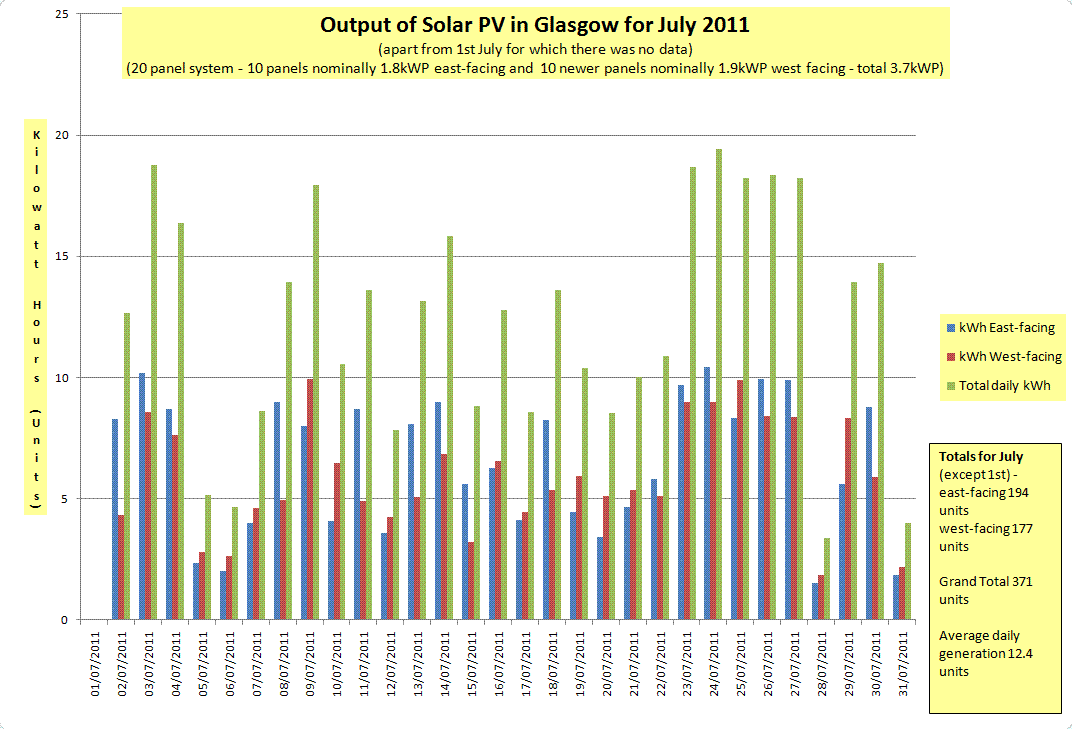
Note that the east-facing panels are slightly south of east, and the second lot of west-facing panels are actually slightly north of west.
At this stage it's hard to say whether the generation total for July for the east-facing panels (194 units) was larger than the total from the west-facing panels (177 units) because of their orientation, or because there happened to be more sun in the morning than in the afternoon.
24 July 2011 - Today the 1000 unit mark was passed, with a total of 1015 units generated (10 panels since January, and another 10 since 8 June).
752 units have been generated by the original 10 east-facing panels, and 263 by the 10 new west-facing panels.
23rd July 2011
Here is a graph of the solar output on a typical sunny July day:
You can see in this graph that the power output from the east-facing panels is greatest in the morning.
Conversely, as you might expect, the power output from the west-facing panels is greatest in the afternoon.
In the middle of the day there is a peak of over 2kW.
There was some cloud, reducing the output during the morning.
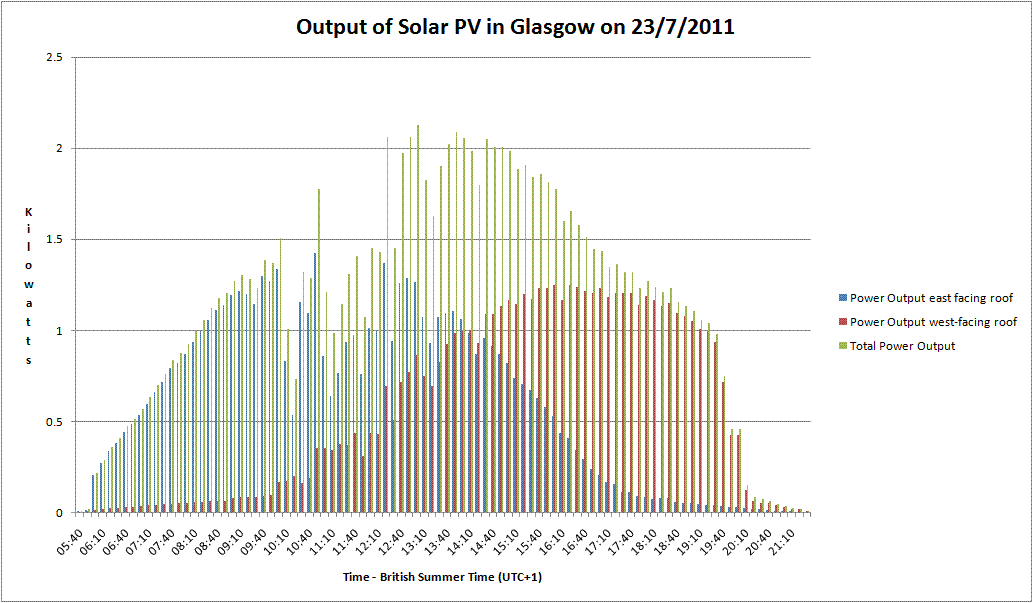
20 July - The total generation to date is 956 kWh.
Today the maximum generation at any time was 2.03kW, the total today was 8.5kW, and generation started at 6.20am and stopped at 8.50pm.
Comparing the east and west-facing roofs, it doesn't really seem to matter that the west-facing one is actually slightly north of west.
Remember that the sun sets north of west in the summer in Scotland, so a bit of north doesn't seem to be a problem.
It's far more important that there are long daylight hours in the summer.
Most of all, generation is at its best when the sun is shining, it's still acceptable when it's bright, and it's only when there are dark clouds or it's very early or very late in the day that generation is poor.
July 2011 - Our electricity provider has now told us that they do not provide export meters, so it's our responsibility to get one if we want to pay for it ourselves.
This means that since 60% of our generated power is exported to the grid, and we are being paid the extra 3.1 p per unit on a basis of an assumed export of 50%, that we are missing out on a few pounds per year (so far it's about £6 in 6 months or so), so it's not really worth the cost of installing an export meter.
Average generation during the 18 June days for which there are data was 10.3kWh and the maximum on any one day was 18.284kWh and the minimum was 2.4kWh. The total for the 18 days was 185.54kWh.
10 June 2011 - the first complete day for which we have Sunny Beam data readings:
Output began at 5am on both sets of panels. It stopped at 9.40pm on the east facing panels, and 9.50pm on the west-facing panels.
The maximum output during any 10 minute period was 2.676kW, some way short of the theoretical maximum of 3.04kW, because the sun did not shine brightly.
The output today was 7.9kWh from the east-facing panels, and 10.4kWh from the west-facing panels, a total of 18.284kWh for the day.
These figures reflect the fact that the sun shone more in the afternoon than it did in the morning.
The totals so far are: 489.31kWh from the east-facing panels (installed in January), and 18.04kWh from the new set of panels installed on 8th June, a total generation so far of 507.35kWh.
It's easy to get the readings from the Sunny Beam monitor into the computer. You just plug it in like any other USB device, such as a camera or card reader, and there are the files in a folder called SBEAM.
You just copy them on to your hard disc, and they can be opened by double clicking on them in a spreadsheet program such as Excel, or Open Office.
8 June 2011 - had 10 more solar PV panels installed on the west-facing roof. Peak output should now be (theoretically) 80% of 3.7kW peak, or 2.96kW, if the sun were to shine all day, an unlikely scenario in Glasgow!
We have now acquired a Sunny Beam monitor as part of the installation process of the west-facing set of panels. This will now replace the Owl monitor, which was inaccurate when the output was low.
The Sunny Beam is a small device which takes inputs of data from the solar panels every day, and as well as a display of the current output, produces a CSV file for each day which it updates with a live output reading every 10 minutes.
Readings are available separately for each string of 10 panels, followed by a total for each set of panels for the day, and a total for each set of panels since they were installed.
In addition a new CSV file is updated daily during each month, with daily totals for each set of panels for the past calendar month.
7 May 2011 - sent off the reading of 322 units generated, of which 197 units were exported to the grid, to our electricity supplier. That's 322 units in 100 days, or 3.22 units per day from 10 east-facing panels.
In the last 8 days, when it has been sunny most of the time, we generated 322-253 or 69 units - that's 8.6 units per day.
We'll see how quickly the feed-in tariff cheque arrives!
We have just ordered 10 more panels for the west facing roof, to be installed in June, because we are missing out on generating from the evening sunshine.
The hope is approximately to double the output that way. You really need sun or at least brightness to get a decent output.
We're getting less than 150 watts when it's cloudy, but about 1500 watts when it's sunny in the morning. The capacity of our system is nominally 1800 watts, but it's east facing so we expect a maximum of 80% of that output.
Along with the new panels, we are going to install a SunnyBeam monitor, which should give readings from both sets of panels.
We have tried the Owl meter, which is cheap and gives a fairly good indication of what you are producing, but is not always accurate enough. Its sensor is wrapped around the output cable, rather than wired into the system. The Owl meter disagrees with the Sunnyboy inverter reading, exaggerating the output significantly when the power output is low (e.g. 100 watts output will produce a false reading on the Owl of 150 watts). When the output is high (500 watts or more), there is an almost exact match.
We want to know at the time exactly how much we are generating, so that we know what we can use for nothing! It's more economic to use the electricity you generate than to export it.
29 April 2011 - We have now reached 253 units since January 27th.
We have bought a low wattage kettle (750 watts) from the Caravan Shop in Glasgow, to boil water using solar electricity when the output is low.
With a bit of planning, you can afford to wait an extra minute or two for your coffee if it's costing you nothing! Using a 3000 watt kettle is not necessary.
If you're generating 750 watts, that's a coffee for nothing with a low wattage kettle, but with a 3kW kettle, you're paying for electricity to boil 3/4 of the coffee, and only generating 1/4 of what you need!
Whether the low wattage kettle is economically worth while will depend on how long it lasts, and when you use it in relation to the power output, so it's a complicated calculation, but it feels good to use less electricity and produce less greenhouse gas.
25 March 2011 - With the days getting longer and the sun getting higher now that we have passed the equinox, daily electricity production has increased.
The maximum daily output was over 7 kWh recently, and the total since 27th January was 103.4 kWh today, with 51 kWh being exported.
An OWL+USB Wireless Electricity Monitor is now on order, to see what the current output is without having to go in the loft and read the inverter display.
18 March 2011 - A brilliantly sunny morning with cloudless blue sky. At 8.22am, the panels are producing 980 watts and have already generated 1kWh. The total generated is now 74kWh since the system was installed on 27th January, with 42kWh used and 32kWh exported.
28 February 2011 - After one month, including three days with a lot of sun, and 28 largely or completely cloudy days, the daily peak so far was 5.13 kWh, generated today.
The total now generated since 27th January stands at 43kWh, of which 23kWh were used, and 20kWh have been exported to the grid.
So far, since 7th February when we started earning the feed-in tariff, we appear to have earned:
43kWh - 11kWh = 32kWh generated, of which 16kWh have been used and 16kWh have been exported.
Generated and Used:
16 * 41.3p generated + 16 * 10p saved = £8.20
Generated and Exported
16 * 41.3p generated + 16 * 3p exported = £6.90
Total of feed-in tariff, export earnings and savings = approximately £15.10 in 21 days.
10 February 2011 - The panels have now been in operation for two weeks.
In 14 days, they have generated 14.3kWh, during a period of mostly cloudy weather since 27th January when they were installed.
3.71kWh of that total was generated today, when for once the sun shone all day, and the output during the late morning was over 800 watts - enough to run a dehumidifier (180 watts), the fridge (80 watts) and the freezer (120 watts), none of which are on all the time, as well as all the light bulbs, so we did export some power to the grid.
The system is only slightly south of east-facing, so as we expected, peak output was in the morning, and it got down to 2 watts output then stopped generating at 4.35pm.
So on average that's 1kWh per day during the first two weeks in February.
If you discount the sunny day, in 13 cloudy days with some brightness but not a lot of sun, we generated 10.59kWh, or an average of .814 kWh per day, during 96 hours of generation, or 6.85 hours of generation per day - even in cloudy Glasgow.
At its worst, (apart from snow on the panels which would stop generation altogether), there is still enough power to light several low-wattage light bulbs for most of a cloudy day in winter in Glasgow with an east-facing installation of 10 Topsola panels.
7 February 2011 - received and was able to send to our energy supplier by email the MCS Certificate (the installer has one, but the actual installation in your house gets one (a different one!) as well - that's the one which is needed by the energy suppier), which enabled us to earn the feed-in tariff from today (annoyingly not from the installation day as we subsequently discovered!) The delay was not with us, or with Absolute Solar and Wind, but we have lost the feed-in tariff for 10 (fortunately mostly cloudy) days of generation. Well in 25 years time - who will care about a fiver? The total generation so far by today was 11.4kWh, so we have still saved £1.14 by not paying for that power!
31 January 2011 - It turns out that the smart meter is smart enough to keep a note of the electricity which we export to the grid, as well as the electricity which we are using.
Cloudy weather has limited generation to 4.7kWh in total so far over 4 days, (of which 1kWh has been exported to the grid).
Peak output today was 105 watts about 3pm when a brief glimpse of the sun appeared. That was enough to run 10 average-powered low energy light bulbs, but probably only for a few minutes!
By 4.30pm, when it was still light but very dull, no electricity was being generated.
27 January 2011 - Solar Panel installation completed in the promised three days, tested and started generating - only a little, as it was late in the day when it was commissioned.
Near the fuse box two extra small boxes have appeared - a switch for the inverter, and a meter which tells you how much electricity you've generated.
Contacted our electricity supplier and received by email a feed-in tariff application form.
21 January 2011 - Today it was bright and the frost cleared, so it was safe to go on the roof.
The rails to bolt the solar panels to went up on the roof, and the inverter was wired in to the mains.
There will be no more activity till next week, when they are due to come back and install the panels themselves.
20 January 2011 - The fitters from Absolute Solar and Wind came today. They could not go on the roof as it was too frosty and slippery, so they installed the SunnyBoy Inverter, and the cables from the inverter to the main fuse box.
We had to clear part of the loft to allow access for the fitters to install the cable, and holes in ceilings had to be drilled and a small section of trunking for a single cable from the loft through to the fuse box.
7 January 2011 - paid a deposit for the PV installation, which confirmed the order. After this, there was a 7-day cancellation period.
Contacted Glasgow Council Planning Department (Development and Regeneration Services), who advised that no planning permission was needed, so we decided to go ahead with the installation.
late December 2010 - gave a verbal (provisional) order for the solar panel installation, during one of the coldest winter spells for 50 years.
November 2010 - Had a home visit from the Energy Saving Trust, who wrote us a free home energy report.
We received 3 visits from sales people from different solar panel companies, and obtained quotes for the solar panel installation.
August 2010 - a smart meter was installed (free) by our electricity supplier as part of their normal upgrading programme.
This is coincidental to the later fitting of our solar panels, but the bluetooth display which comes with it has proved useful in monitoring their performance.
